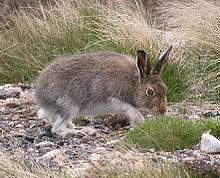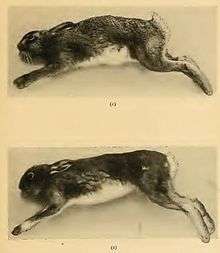Mountain hare
| Mountain hare [1] | |
|---|---|
 | |
| Mountain hare in its summer pelage | |
| Scientific classification | |
| Kingdom: | Animalia |
| Phylum: | Chordata |
| Class: | Mammalia |
| Order: | Lagomorpha |
| Family: | Leporidae |
| Genus: | Lepus |
| Species: | L. timidus |
| Binomial name | |
| Lepus timidus Linnaeus, 1758 | |
 | |
| Mountain hare range (green - native, red - introduced) | |
The mountain hare (Lepus timidus), also known as blue hare, tundra hare, variable hare, white hare, snow hare, alpine hare and Irish hare, is a hare that is largely adapted to polar and mountainous habitats.
Distribution
This species is distributed from Fennoscandia to eastern Siberia; in addition there are isolated mountain populations in the Alps, Ireland, Scotland, the Baltics, northeastern Poland and Hokkaidō. The mountain hare has also been introduced to New Zealand, Iceland, Shetland, Orkney, the Isle of Man, the Peak District, Svalbard, Kerguelen Islands, Crozet Islands, and the Faroe Islands.[3][4][5] In the Alps, the mountain hare lives at elevations from 700 to 3800 m, depending on biographic region and season.[6]
Description

The mountain hare is a large species, though it is slightly smaller than the European hare. It grows to a length of 45–65 cm (18–26 in), with a tail of 4–8 cm (1.6–3.1 in), and a mass of 2–5.3 kg (4.4–11.7 lb), females being slightly heavier than males.[7][8] In summer, for all populations of mountain hares, the coat is various shades of brown. In preparation for winter most populations moult into a white (or largely white) pelage. The tail remains completely white all year round, distinguishing the mountain hare from the European hare (Lepus europaeus), which has a black upper side to the tail.[7] The subspecies Lepus timidus hibernicus (the Irish mountain hare) stays brown all year and individuals rarely develop a white coat. The Irish variety may also have a dark/grey upper surface to the tail, which in other populations always remains white.
Behaviour
_Lepus_timidus.jpg)
Studies have shown that the diet of the mountain hare varies from region to region. It seems to be somewhat dependent on the particular habitat that the population under study lives in. For example, in northern Scandinavia where snow may blanket the ground for many months, the hares may graze on twigs and bark. In areas where snowfall is rare, such as Ireland, grass may form the bulk of the diet. Given a choice, mountain hares in Scotland and Ireland seem to prefer feeding on grasses. One study looking at mountain hares on a coastal grassland environment in Ireland found that grasses constituted over 90% of the diet. This was higher than the percentage of grass in the diet of the European rabbit (Oryctolagus cuniculus) that inhabited the same environment. The mountain hare is regionally the favourite prey of the golden eagle and may additionally be predated by Eurasian eagle-owls and red foxes. Stoats may prey on young hares.[8]
In northern parts of Finland, Norway and Sweden, the mountain hare and the European hare compete for habitat. The European hare, being larger, is usually able to drive away the mountain hare but is less adapted for living in snowy regions: its feet are smaller and its winter fur is a mixture of white and brown. While this winter fur is actually a very good camouflage in the coastal regions of Finland where the snow covers the shrubs but for a short time, the mountain hare is better adapted for the snowier conditions of the inland areas.
The Arctic hare (Lepus arcticus) was once considered a subspecies of the mountain hare, but it is now regarded as a separate species. Similarly, some scientists believe that the Irish hare should be regarded as a separate species. Fifteen subspecies are currently recognised.[2]
Mountain hare and tourism
Winter tourism in the European Alps has developed rapidly over the past few decades, leading to the expansion of ski resorts, growing numbers of visitors and a massive increase in snow sport activities such as free-ride skiing and snowboarding, backcountry skiing and snowshoeing. A study about such stress events and reactions of mountain hares indicated that mountain hares living in areas with frequent human winter recreational activities show changes in physiology and behaviour that demand additional energy in winter, when access to food resources is limited by snow. In the Alps the mountain hare lives at elevations from 700 to 3800 m above sea level depending on biographic region and season.[9]
In August 2016, the Scottish animal welfare charity OneKind launched a campaign on behalf of the mountain hare, as a way of raising awareness of mountain hare culls taking place across the country and in garnering public support for the issue. Mountain hares are routinely shot in the Scottish Highlands both as part of paid hunting ‘tours’ and by gamekeepers managing red grouse populations (who believe that mountain hares can be vectors of diseases which affect the birds). Much of this activity is secretive but investigations have revealed that tens of thousands of hares could be being culled every year. The campaign, which urges people to proclaim that ‘We Care For The Mountain Hare,’ will culminate with the charity urging the Scottish government to legislate against commercial hunting and culling of the iconic Scottish species. The campaign has revealed widespread public support for a ban on hare hunting in Scotland.
External links
| Wikimedia Commons has media related to Lepus timidus. |
References
- ↑ Hoffman, R.S.; Smith, A.T. (2005). "Order Lagomorpha". In Wilson, D.E.; Reeder, D.M. Mammal Species of the World: A Taxonomic and Geographic Reference (3rd ed.). Johns Hopkins University Press. p. 204. ISBN 978-0-8018-8221-0. OCLC 62265494.
- 1 2 Lagomorph Specialist Group (1996). "Lepus timidus". IUCN Red List of Threatened Species. Version 2008. International Union for Conservation of Nature. Retrieved January 28, 2010.
- ↑ LONG JL 2003. Introduced Mammals of the World: Their History, Distribution and Influence (Cabi Publishing) by John L. Long (ISBN 9780851997483)
- ↑ http://www.hare-preservation-trust.co.uk/mountain.html
- ↑ http://iberianature.com/wildworld/guides/wildlife-of-the-faroe-islands/mammals-of-the-faroes/
- ↑ Rehnus, M.: Der Schneehase in den Alpen. Ein Überlebenskünstler mit ungewisser Zukunft, Haupt Verlag, Bern 2013, ISBN 978-3-258-07846-5, p. 21
- 1 2 "Mountain Hare". ARKive. Retrieved January 28, 2010.
- 1 2 Macdonald, D.W.; Barrett , P. (1993). Mammals of Europe. New Jersey: Princeton University Press. ISBN 0-691-09160-9.
- ↑ Rehnus, M., Wehrle, M., Palme, R.: Mountain hares Lepus timidus and tourism: stress events and reactions, Journal of Applied Ecology, http://onlinelibrary.wiley.com/doi/10.1111/1365-2664.12174/abstrac
